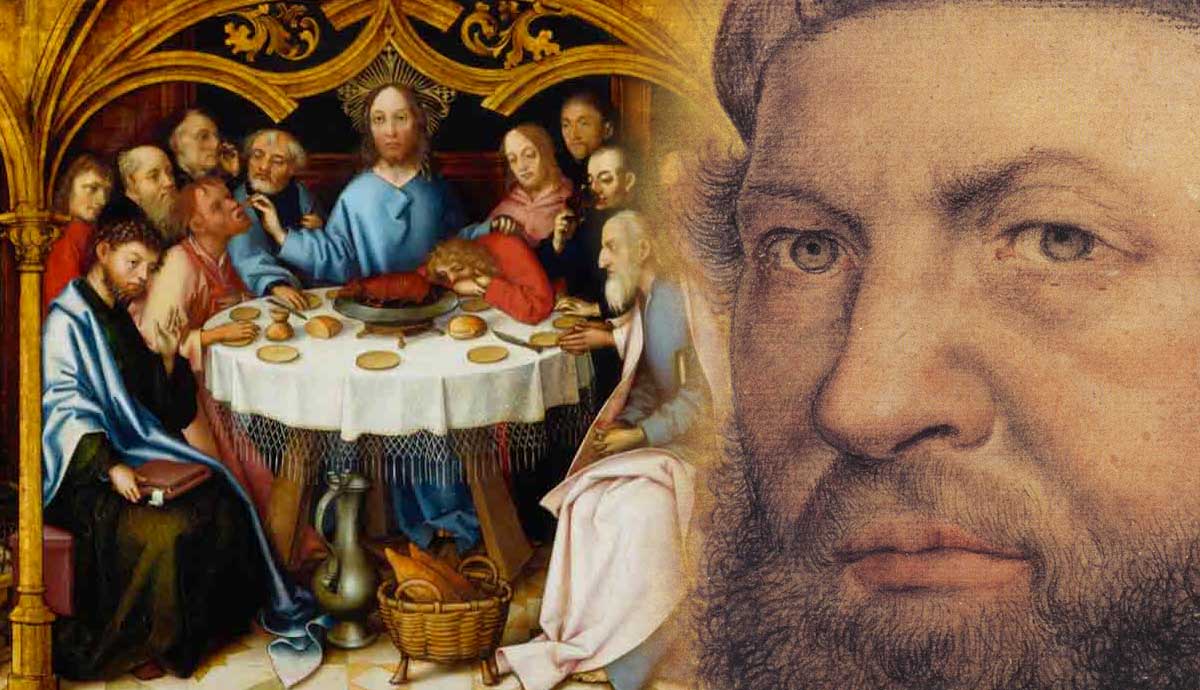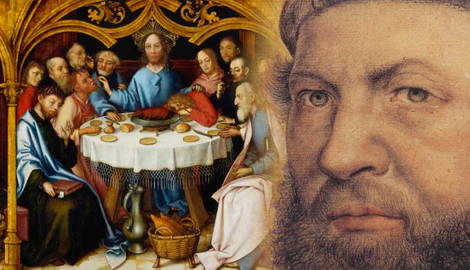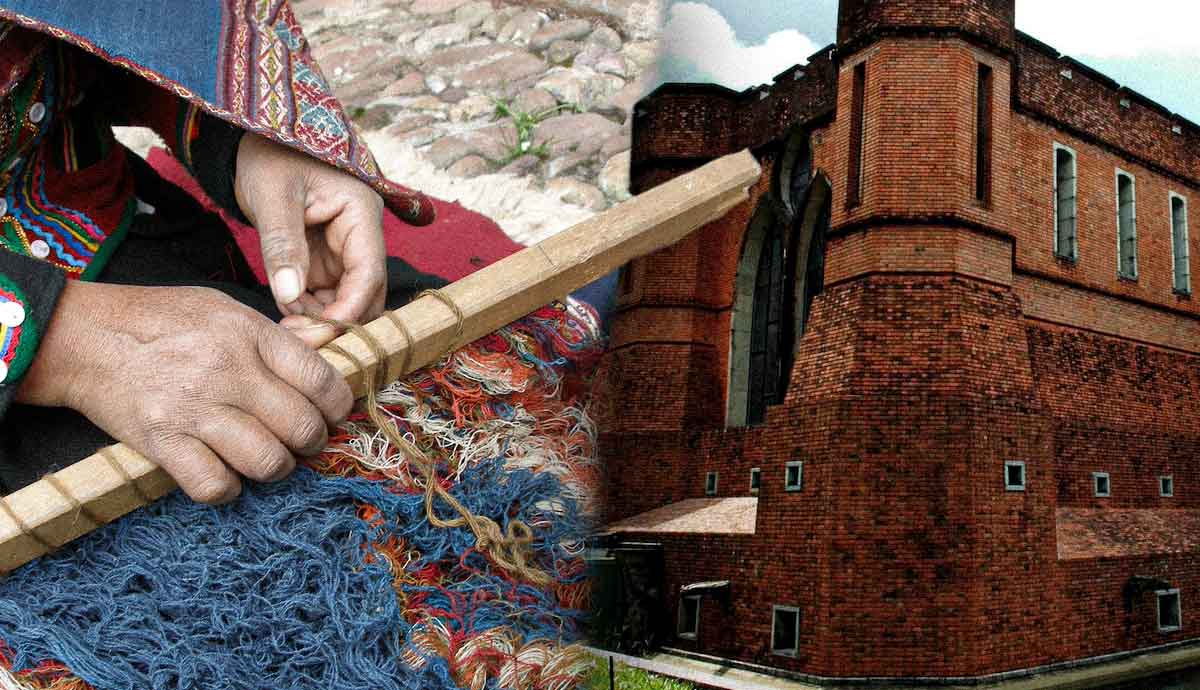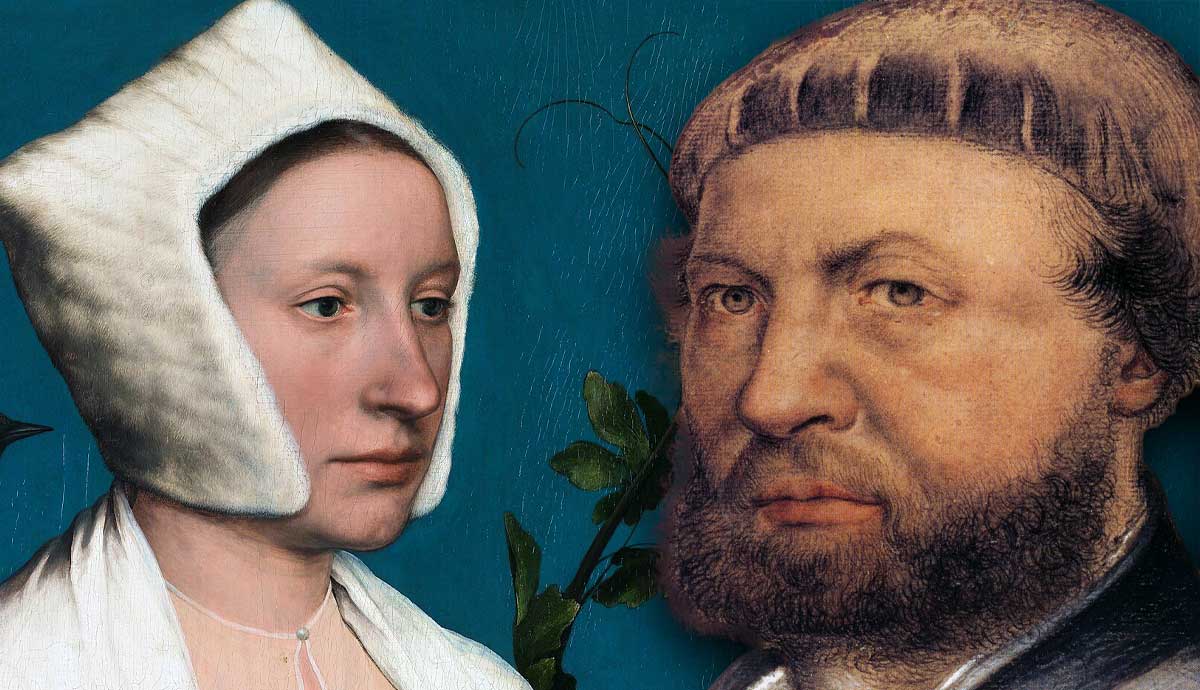
Hans Holbein the Younger’s religious beliefs are a subject of debate. Beginning his artistic career as a continuation of his Catholic father’s legacy, Holbein experienced radical change and adapted appropriately in order to survive. Was his neutrality strategic, or have his true beliefs been lost to time? Continue reading to learn more about the mystery behind the famous artist’s religious beliefs.
Who Was Hans Holbein the Younger?

Hans Holbein the Younger had a personal history with religious art. His father, Hans Holbein the Elder, was a 15th-century German artist from Augsburg, Bavaria. He likely trained as an artist in Cologne and the Netherlands and specialized in religious art as a painter, printer, goldsmith, and sculptor. He had two sons who continued his legacy as an artist: Hans Holbein the Younger and his brother, Ambrosius Holbein.
When Holbein the Elder was commissioned for a mural in Basel, his sons went with him to assist in the project. Hans Holbein the Elder had trained his sons their entire lives to become artists, as was tradition for sons to follow in their fathers’ footsteps in the sixteenth century. However, they were now in their adult years, and it was time for his sons to branch off and create their own careers. Ambrosius Holbein would, unfortunately, die young, but his brother, Hans Holbein the Younger, would continue working as an artist until he died in London in 1543.
Basel would eventually become Hans Holbein the Younger’s new home. Here, he would establish himself as an artist, marry a tanner’s widow, produce children, and develop his career. In 1519, Hans Holbein the Younger became a burgher of Basel when he was admitted into a painter’s guild.
The Religious Art of Hans Holbein the Younger

Dead Christ is a prominent example of Hans Holbein the Younger’s religious artwork, created during his time in Basel before the coming of iconoclasm. Holbein’s painting style was inspired by the artist Matthias Gruenewald, who rejected the idealism seen in classical revivalist paintings of the Renaissance. Instead, he embraced the Gothic tradition.
Gruenewald painted dead bodies to appear realistically gruesome rather than idealizing the figures in his work, famously seen in the Isenheim Altarpiece, in which a panel depicts a crucified Christ as green, bloated, and rotting. There is no glorification or beauty in the flesh of the crucified victim. His death is not glorified through the ancient practice of idealism but instead displayed realistically. Similarly, Holbein followed suit by depicting Christ with a greenish tint, resembling a color that would happen naturally to a human body after death. Holbein’s religious artwork would sustain him and his family until the religious reformation came to Basel, throwing the community into a divided turmoil.
Iconoclastic Riots

In 1517, a German priest named Martin Luther nailed a list of complaints against the Catholic Church on the door of a church in Wittenberg, Germany. This act set off a Protestant Reformation across the European continent and would divide entire populations as ideas of reform traveled across the lands. In 1529, roughly ten years after making a career for himself in Basel as a painter of religious artwork, iconoclastic riots erupted in Basel.
Angry hordes of people stormed into the church, smashing and destroying any artwork that they deemed to be icons. It was a Protestant belief that iconoclasm was a severe sin that caused worshipers to worship physical artwork depicting divine beings rather than genuinely worshiping God. By 1530, Holbein had ceased working with religious subjects altogether, instead transferring his skills to more secular artwork, such as murals for the town hall or portraiture. At that point in time, he had already had two years of experience with portraiture in England before he returned to Basel in 1528 to witness the iconoclasm.
Holbein knew that the tides were turning and that he could be quickly swept up into the fervor if he was not careful. When Protestant authorities were sent to check the city’s guild members’ religious loyalties, Holbein did not specify which religion he identified with. Instead, he simply asked for clarification on the Eucharist before doing what he believed was expected of him. Therefore, rather than supporting or defending the artwork’s survival, he simply let it go to pursue other genres of art and make his living as an artist another way while blending into the religious atmosphere the best he could. Whether this change in course of action was spurred by a change of beliefs or a sense of survival is unclear.

Holbein maintained neutrality as much as possible, but there are instances where his religious beliefs may shine through, though always inconclusively. The Coverdale Bible is a significant clue to Holbein’s religious beliefs. Despite creating religious artworks as a Catholic in his youth, after the iconoclastic riots of 1529, he sought work elsewhere. He found a position as a designer for a local printer in Basel, and one of the books he was to design was the Coverdale Bible. Myles Coverdale compiled the Coverdale Bible, the first complete edition of the Bible to be translated into English. The only previous version of the Bible available to English monolinguals was the Tyndale Bible, which was only a portion of the Bible.
The Catholic Church believed that their sacred texts should be kept from the everyday people by making them inaccessible via language. If the Bible was only written in Latin, then only Latin-knowing members of the Church could understand the text, and that put the power into their hands to spread the word of God and display it in a context that suited the Church. If the masses could read the Bible in their vernacular language, they could form independent opinions that did not align with those of the Church.
Holbein’s Connections and Opinions

In 1523, Holbein and a famous humanist, Erasmus of Rotterdam, both lived in Basel. They became close friends after Erasmus commissioned Holbein for two portraits of himself. Erasmus connected Holbein to Sir Thomas More in England, a staunch Catholic who would eventually meet his end due to the Protestant Reformation in England.
More had heard of Holbein’s talents from their mutual friend and invited Holbein to stay with him and his family in England. Holbein did just that, leaving his family behind in Basel and staying in England for two years in 1526-1528. He returned to Basel briefly, but by 1533, he was permanently living and working in England as an official court painter to Henry VIII.
At this point, Henry VIII was notably Protestant, known for his violent and unpredictable temper, and disliked the idea of anyone not bending to his will. It would not have been possible for his court artist to be openly Catholic, but Holbein’s private beliefs still remain unknown under these circumstances.
In Ship with Revelling Sailors, we can see a scene that is precisely the opposite of what would be acceptable in a church. Some sailors climb and pull on ropes to continue the smooth sailing of the ship, while others drink alcoholic beverages from giant jugs, pouring the liquid down their throats dramatically. The drinking has already begun to affect many of the sailors. One sailor gropes a woman inappropriately through her skirt. Next to them, another sailor leans over the deck and vomits into the sea below.

These paintings may have been an observation by Holbein on society’s sins and vices. Ship with Revelling Sailors was a preparatory sketch for a painting that would have been part of a three-painting series on wealth and poverty, none of which survive today. These paintings were created during his time in England, shortly after the coronation of Anne Boleyn, who brought the Protestant Reformation to England when Henry VIII broke from the Catholic church to annul his first marriage to Catherine of Aragon after she failed to give him a son.
It is possible that Holbein retained his Catholic beliefs privately and expressed his dissatisfaction by producing artwork depicting the world’s follies, though there is no evidence to prove this theory. The idea that Holbein could have held onto his Catholic beliefs while making his way through a Protestant landscape could indicate that he felt a loyalty to his past while simultaneously wishing to refrain from being left out of the present. Indeed, the earliest indication of Hans Holbein the Younger’s existence is a religious painting by his father, who lovingly painted his young sons into the biblical scene.
However, a refute to this theory could be Holbein’s close friendship with Erasmus of Rotterdam, known for his famous work of literature, In Praise of Folly. With this in mind, it could also be concluded that Holbein shared sentiments with his friend regarding the foolish vices of humanity and that it simply was a commentary on mankind’s follies, rather than religious beliefs. It could be entirely neutral to religion.
Hans Holbein the Younger at the Tudor Court

Holbein became highly successful at the Tudor court, and his religious beliefs remain unknown to art historians. Evidence points neither to a conversion to Protestantism nor a sense of loyalty to Catholicism. It points only to his work and the opportunity he was able to find to create a lucrative career for himself. Holbein must have been well-liked, for Henry VIII kept him as an official court painter until he died in 1543, despite being unhappy with his portrait of Anne of Cleves in 1539, which notoriously caused a conundrum for the King.
The art historian Jeanne Nuechterlein declares, in her book Holbein: The Artist in a Changing World, that Holbein’s career goals centered around creating realistic artwork that looked persuasively tangible but that included slight changes to enhance the meaning or overall effect of the completed picture. Perhaps this was his goal with his religious beliefs—to exist in a state of neutrality when under the public eye, to allow himself a real place in the world without his religious identity holding him back due to Europe’s hostile and divided nature at the time.

He had a history with Catholicism. He had created religious artwork for the Catholic church, and his father had taught him in those traditions. His brother had grown up beside him, learning religious art from their father before his young life was cut short. He had supported his family with his religious art. Yet, when the iconoclasts came to Basel, he did not show support for either side. In fact, he went on to design the Coverdale Bible, which the Catholic church was openly against. He had been friends with prominent Catholics yet had used those Catholic connections to obtain a position at the Protestant English court, where he was employed directly by the head of the Church of England.
He had critical commentary on wealth and poverty shortly after the Protestant reformer Anne Boleyn became Queen, yet there is no evidence that his critique was directed towards the Queen or her religious beliefs. Holbein focuses not on the beliefs of those around him but on their likenesses. His neutrality allowed him to exist in both halves of a divided Europe.










